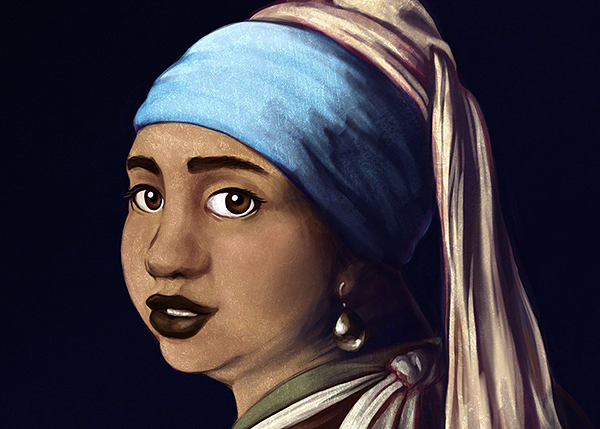Danelle Malan, co-autora de CottonStar, em entrevista
Publicado25 Dez 2014

Imagem: Reka with a pearl earing
Danelle Malan é uma ilustradora sul-africana, formada em Belas Artes e especializada em Pintura pela Michaelis School of Fine Art, co-autora de Cottonstar, um webcomics criado em 2008, disponível on line desde 2011 e que em 2012 teve a primeira edição em papel. Uma história distópica, num mundo em grande parte submerso, que imagina uma Cidade do Cabo alternativa, num futuro incerto, protagonizada por Renier du Preez, grumete a bordo do navio CootonStar. Na série de entrevistas do site ArtSouthAfrica a criadores de banda-desenhada, Danelle Malan fala sobre o estado da arte no continente africano, o que distingue a banda-desenhada de outras expressões artísticas e a relação entre os criadores africanos e influências de outros continentes, entre outros temas.
What is the current position of comics and other related media in South Africa and the African continent? Have we arrived or are we still on the journey?
(Speaking only for South Africa as Africa is really huge and I can’t even name half the countries in it!) We are most certainly still on the journey. In fact, I am not sure if there is an end to journeys like this! If you mean, “Are we at international standard yet,” I’d say we are closer talent wise and not so close industry wise. We’re still very insular and few people in South Africa can name local comics other than Bitterkomix and Madam and Eve, and of course the political cartoon greats like Zapiro and Fred Mouton. All of these are closely linked to politics and social commentary. I think a large part of the problem is that people pessimistically still cling to the assumption that if anything was produced in South Africa, it’s of inferior quality. This is obviously not the case, and we need to keep on pushing out high quality work until that perception changes.
What can comics do that other art and literary forms cannot in our local context?
The biggest and most obvious point which I am sure other people will also mention is that pictures are more universally accessible than words. A scene of violence or friendship can be read in any language with no words needed. The use of imagery with words is a great way to open up a piece of writing to an audience that would not normally engage with it. And of course if you add humour, it has the added benefit of bringing home a message or narrative where completely serious art or writing would have missed the mark. People who not normally engage with something are drawn in effortlessly. Humour is inclusionary and has a disarming effect. That is not to say humour won’t piss people off if used in a certain context (like political cartooning), but you get the gist of my reasoning.
Do we draw our inspiration from the USA and Europe rather than the rest of the continent? Should we be engaged more closely with creatives from Africa?
It varies greatly. I know a lot of the local comics producers personally and everyone seems to be doing what they enjoy, and a great deal of that stuff is experimental. On the one hand we have people like the Trantraal brothers and Anton Kannemeyer who draw heavily and directly from the tumultuous landscape that is South African socio-political issues. Then on the other hand we have people like Luis Tolosana whose short, wordless comic Phylo’s Wish deals with issues of poverty, the separation of the classes, and escapism – topics which are extremely relevant to South Africa, but which are at the same time universally accessible, because they are global issues, too. Then you get the other end of the spectrum, where people write pure fantasy which contains little to no humans at all, such as Deon de Lange’s Gofu, and Tomica, for which David Covas Lourenco does the writing. With our own project, Cottonstar, the milieu is still South Africa… but a hypothetical (and by that we mean pretty much completely fabricated) future South Africa in which global warming has covered the world in water and left only a few bits of dry land sticking out. We reference South African culture heavily, but are not limiting ourselves to it, and because the global playing field has changed so drastically, it’s easier to apply artistic license to social and economic issues.
